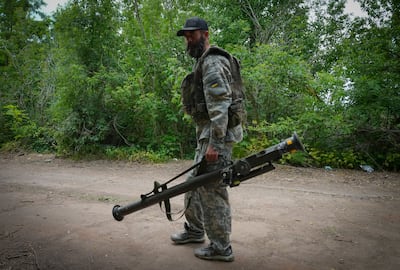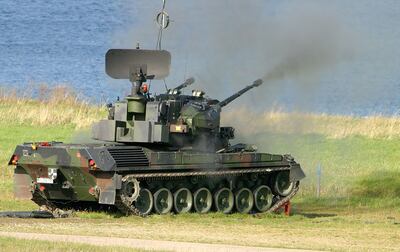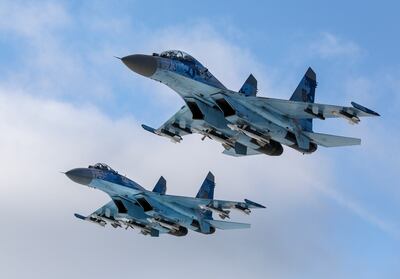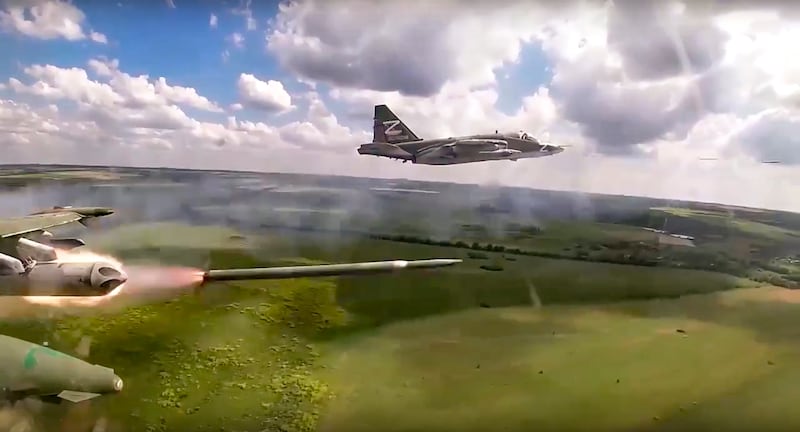The full modernisation of Russia’s air force appeared to have been completed after it pummelled Syria with some precision while upgrading its strike capabilities with 300 modern frontline jets.
In the build-up to the Ukraine invasion, respected military thinkers suggested that overwhelming numbers and the superior technology of Moscow’s air armada would give them dominance of the skies.
Events have proved them wrong. For the first time in the five decades since the Vietnam War, air power has been emasculated by air defence, to the point that all the Russians can now achieve is firing cruise missiles from bombers within their own territory.
The unexpectedly ineffective performance of its air force, known as the VVS, led Britain’s Ministry of Defence to question Russia's ability to influence the war.
“In recent months, the number of sorties conducted by Russian tactical combat aircraft over Ukraine has reduced significantly,” it tweeted.
“Russian aircraft now probably conduct tens of missions per day, compared to a high of up to 300 per day in March 2022.”
Moscow’s losses have been high, with at least 67 fixed-wing aircraft having been shot down during the war, including a Su-24 fighter-bomber and a Su-25 ground attack plane last week.
“When it is used well, air power has a devastating effect,” says Justin Crump, chief executive of Sibylline, an intelligence consultancy.
“But the use of air power by Russia has been well below expectations and their failure to overcome Ukrainian air defences early in the campaign has meant that attacks near the front line have been limited.
"There has been no deep strike behind the battlefield. The lack of willingness to take risks has limited the impact of air power in the campaign and, despite this, the Russians have still taken numerous losses, even with the caution on display.”
Military analyst and author Tim Ripley believes that modern missiles have thwarted the air force.
“Traditional air power has not been decisive for either Russia or Ukraine as it has been neutralised by the thickness and effectiveness of both sides’ air defences,” he says.
“This is not so much a failure of air power but a dramatic revelation of the power of modern air defences.”
Suppression attack
A doctrine critical to the US approach to air war is Sead — suppression of enemy air defence. Before anything else, the enemy’s radar, surface-to-air missile batteries and airfields must be neutralised.
This tactic was used effectively in the Gulf wars of 1991 and 2003, as well campaigns in Kosovo, Serbia and Libya.
Although not in its doctrine, the Russian Sead campaign has been half-hearted and ineffectual. When it invaded in February, bombs landed off target, jets were shot down and, crucially, the Ukrainians used deception to move their air defence missiles to secret locations.
In addition, they were given hundreds of US-made short-range Stinger SAMs that made low-level flying a high casualty endeavour.

The VVS it appeared, never recovered. It, too, suffered from the overconfidence and corruption that has undermined other Russian forces, in which apparently excellent equipment has been available only in limited quantities.
It is reported that Russian pilots have been forced to tape commercial GPS devices to their cockpits for navigation. Their bombing accuracy has a mere 40 per cent success rate compared to the pinpoint precision displayed by western coalition forces during the campaigns in Syria and Iraq.
“The VVS has generally been noted by its relative absence from the invasion and has failed to subdue Ukrainian air defences or the Ukrainian Air Force,” writes Justin Bronk of the Royal United Services Institute think tank in London.
Compared to Nato pilots having at least 200 training hours a year, Russia's fliers had half of that, Mr Bronk says. There is also a lack of dedicated Sead units, he adds.
But Mr Crump emphasises that the Russian doctrine on air defence was to “deny Nato the sky, rather than seeking to seize air supremacy themselves”. That doctrine would have to change to find success over Ukraine.
“More sustained, daring and effective VVS operations at the start could have made a big difference,” he adds.
SAM dominance
Of the estimated 20,000 sorties by the VVS, only 3,000 of them have been in Ukraine's airspace, mainly due to strong defences.
Without its highly effective missile defence, Kyiv may well have struggled to hold back the Russian invasion and would likely have suffered the destruction of industry, infrastructure and armed forces.
“It is purely thanks to its failure to destroy Ukraine’s mobile SAM systems that Russia remains unable to effectively employ the potentially heavy and efficient aerial firepower of its fixed-wing bomber and multi-role fighter fleets to bombard Ukrainian strategic targets and frontline positions from medium altitude, as it did in Syria,” a recent Rusi study paper concluded.

Ukraine also shepherded its medium range S-300 SAMs, ensuring they were used effectively to deny Russia air superiority.
At lower levels it created a deadly arena with its batteries of anti-aircraft artillery alongside the Buk mobile missile systems aligned to many man-portable air defences, including the Stingers but also its own Strela and Igla systems.
That has now been enhanced by US-supplied NASAMS, British Starstreak systems, alongside the German Gepard anti-aircraft tanks whose twin 35mm cannons have torn into drones, missiles and aircraft.
Online footage from Ukraine on Tuesday showed a Gepard tank, which has its own in-built radar tracking system, shooting down either a missile or armed drone with two one-second bursts.
Sophisticated air protection is based on “layered-defence” and Ukraine, if it is kept supplied, appears to have this implemented to a sophisticated level.
Bombing beyond borders
The effective Ukraine air defence has forced the VVS to bombard the country with cruise missiles launched from its bombers within Russian airspace.
The strikes have proved effective in targeting Ukraine’s power stations to cut off electricity supplies, demoralise the population and handicap industry.

The latest attack came on Monday but again air defences managed to shoot down 60 of the 70 missiles launched.
It also appears that Ukraine has launched its own unique form of Sead operations, attacking two bomber bases more than 500 kilometres inside Russia, converting old Tu-141 drones into flying bombs likely directed at targets by special forces.
At least three bombers were damaged in the raids, but greater than that was the blow to the VVS’s prestige and Russia’s air defences that failed to deter the attacks, that included a base with its nuclear arsenal.
Western officials said this would force Moscow to disperse its bomber force deeper into Russia and bring in more troops to protect them.
Nato fighters
Ukraine’s relatively small air force has managed to keep fighting, using its own Russian-designed MiG-29 and Su-27 fighters to hold the line.
But its capabilities could change dramatically if it is supplied with a Nato “4.5 generation” aircraft such as the Eurofighter, Rafale or Gripen.

“The Ukrainian Air Force needs modern, western fighters and missiles to sustainably counter the VVS,” the Rusi report said.
“Russian pilots have been cautious throughout the war, so even a small number of western fighters could have a major deterrent effect.”
Another important asset will be the introduction of in-flight refuelling tankers that form the basis of western air power, allowing its fighter aircraft to remain airborne long enough to attack targets identified on the ground.
“The biggest difference is the US Air Force has 300 tanker planes; that means they can do continuous air patrols,” said Mr Ripley.
“This gives them ranges of 2,000 miles [3,220km], the ability to project air power and to dominate the skies.”







